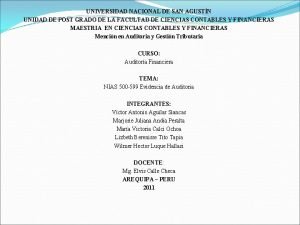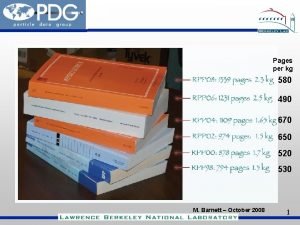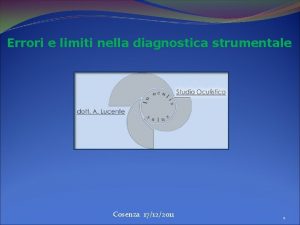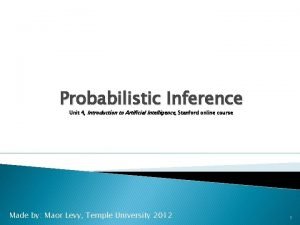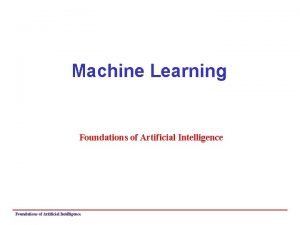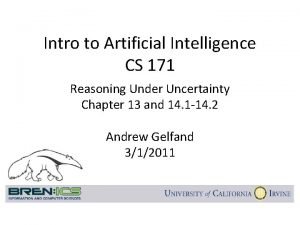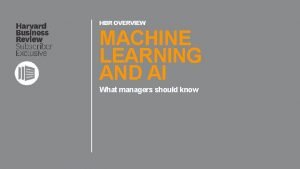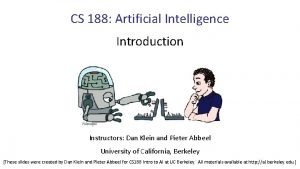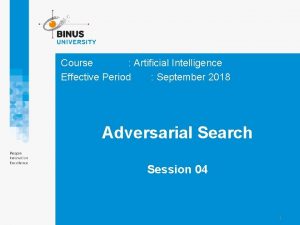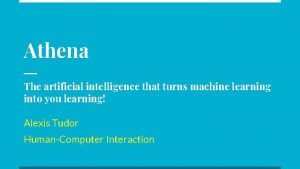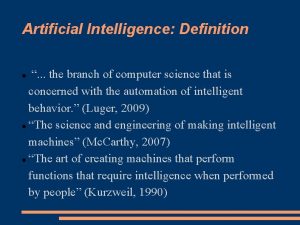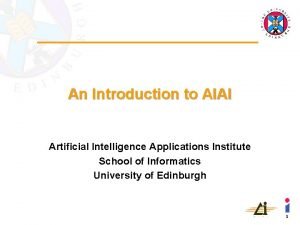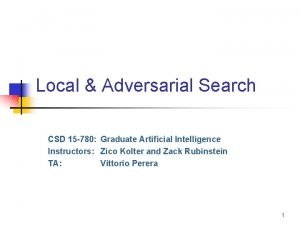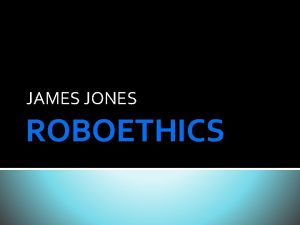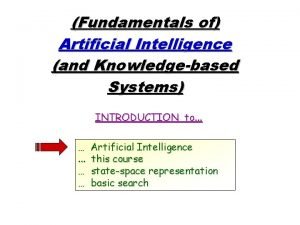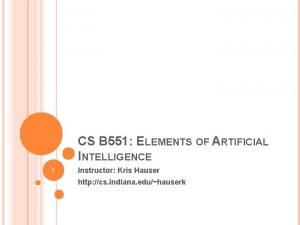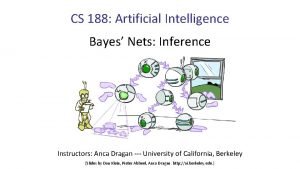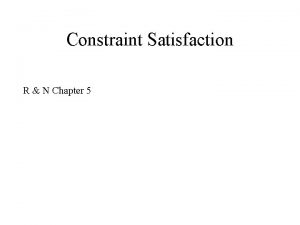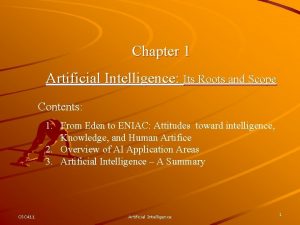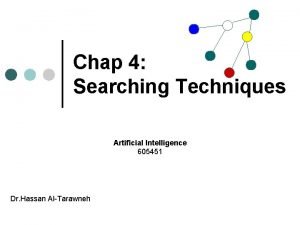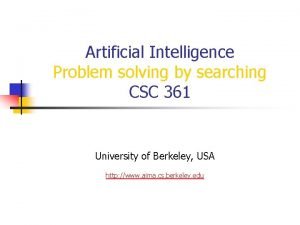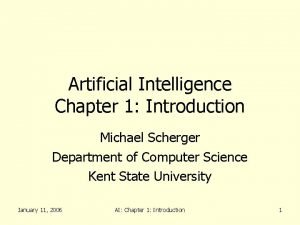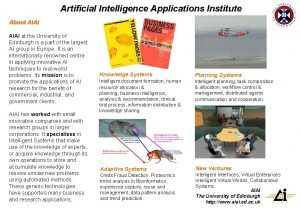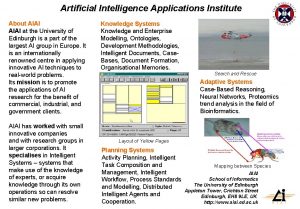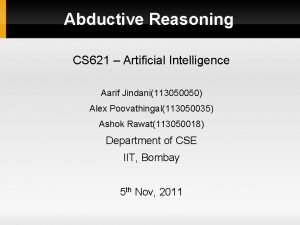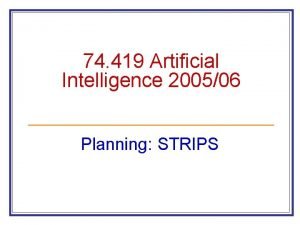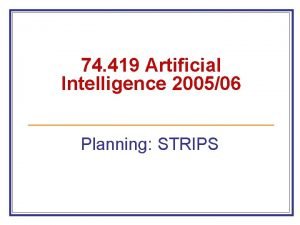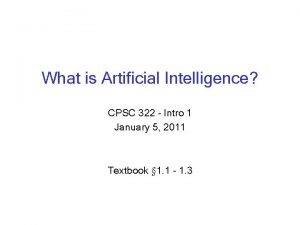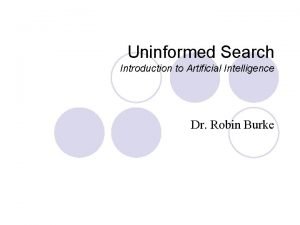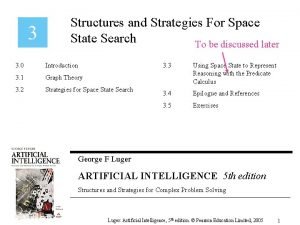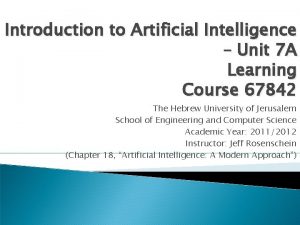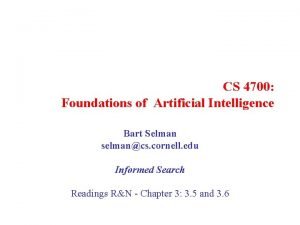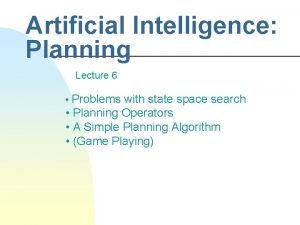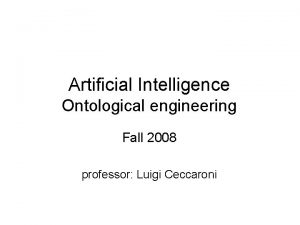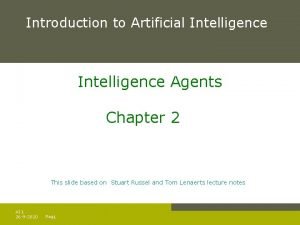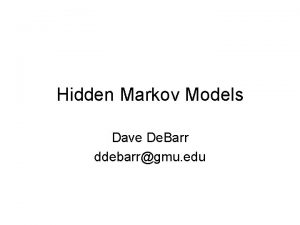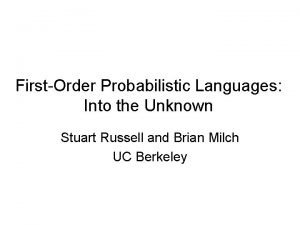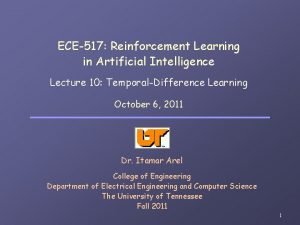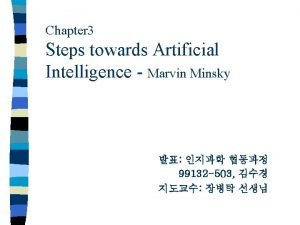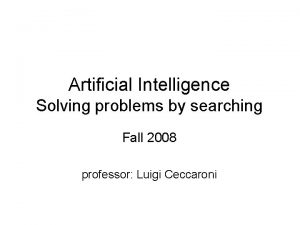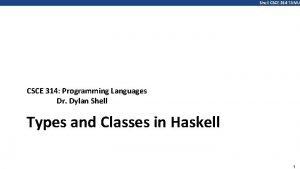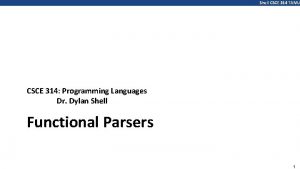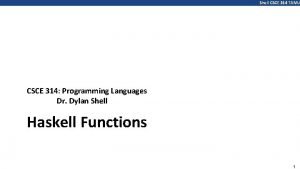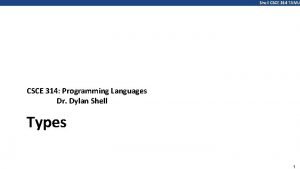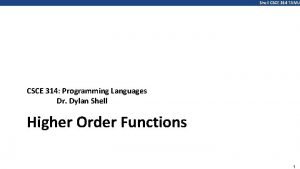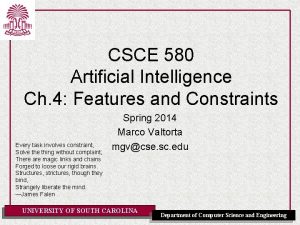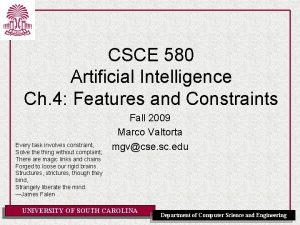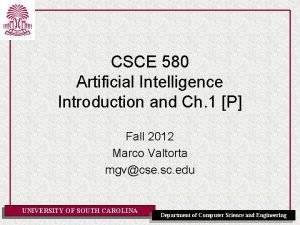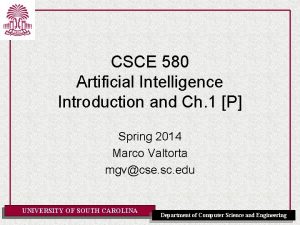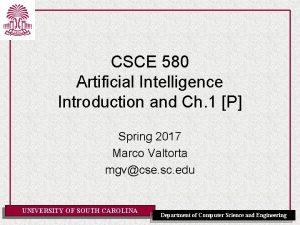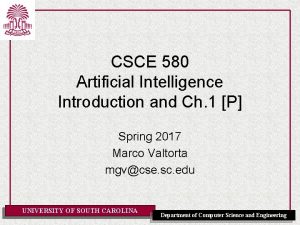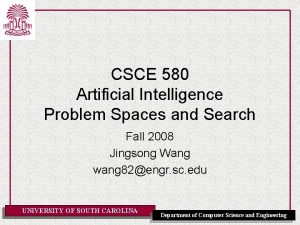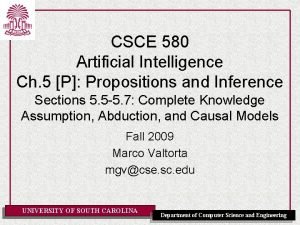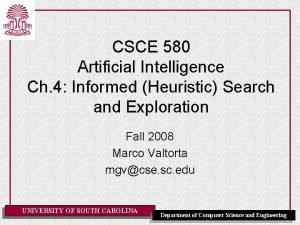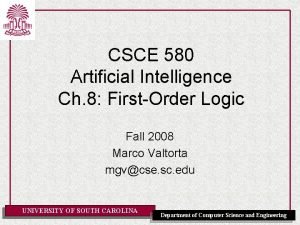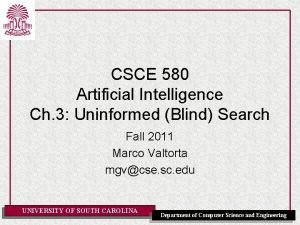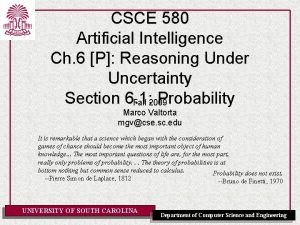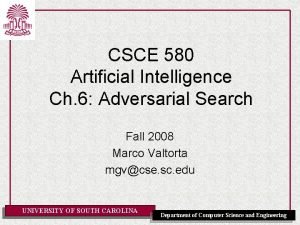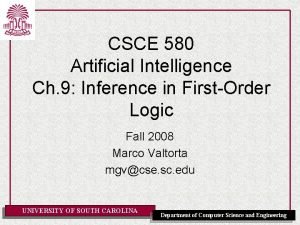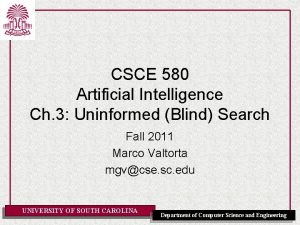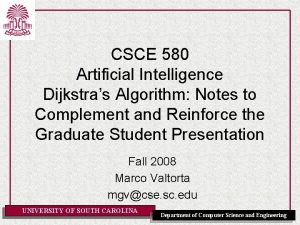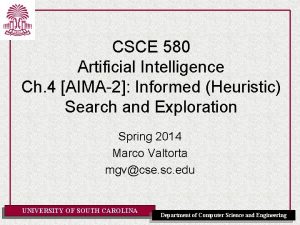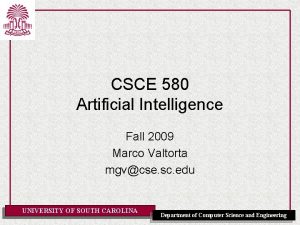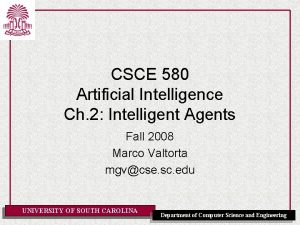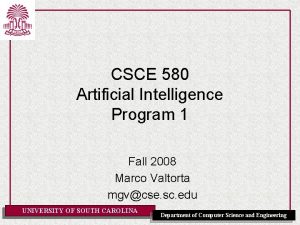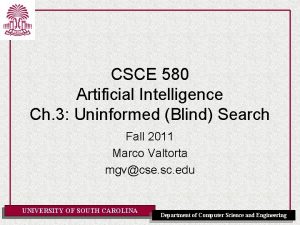CSCE 580 Artificial Intelligence Ch 4 Features and





![Acknowledgment • The slides are based on the textbook [P] and other sources, including Acknowledgment • The slides are based on the textbook [P] and other sources, including](https://slidetodoc.com/presentation_image/e92652f6fa30c9423dd23ca4219e9cf3/image-6.jpg)




![Example 4. 8 [P]: Scheduling Activities UNIVERSITY OF SOUTH CAROLINA Department of Computer Science Example 4. 8 [P]: Scheduling Activities UNIVERSITY OF SOUTH CAROLINA Department of Computer Science](https://slidetodoc.com/presentation_image/e92652f6fa30c9423dd23ca4219e9cf3/image-11.jpg)






















![Iterative Best Improvement [4. 8. 1 P] UNIVERSITY OF SOUTH CAROLINA Department of Computer Iterative Best Improvement [4. 8. 1 P] UNIVERSITY OF SOUTH CAROLINA Department of Computer](https://slidetodoc.com/presentation_image/e92652f6fa30c9423dd23ca4219e9cf3/image-34.jpg)









![Runtime Distribution [Fig. 4. 9 P] UNIVERSITY OF SOUTH CAROLINA Department of Computer Science Runtime Distribution [Fig. 4. 9 P] UNIVERSITY OF SOUTH CAROLINA Department of Computer Science](https://slidetodoc.com/presentation_image/e92652f6fa30c9423dd23ca4219e9cf3/image-44.jpg)






























































- Slides: 106

CSCE 580 Artificial Intelligence Ch. 4: Features and Constraints Every task involves constraint, Solve thing without complaint; There are magic links and chains Forged to loose our rigid brains. Structures, strictures, though they bind, Strangely liberate the mind. —James Falen Fall 2012 Marco Valtorta mgv@cse. sc. edu UNIVERSITY OF SOUTH CAROLINA Department of Computer Science and Engineering

UNIVERSITY OF SOUTH CAROLINA Department of Computer Science and Engineering

Iterative-deepening-A* (IDA*) works as follows: At each iteration, perform a depth-first search, cutting off a branch when its total cost (g + h) exceeds a given threshold. This threshold starts at the estimate of the cost of the initial state, and increases for each iteration of the algorithm. At each iteration, the threshold used for the next iteration is the minimum cost of all values that exceeded the current threshold. Richard Korf. “Depth-First Iterative-Deepening: An Optimal Admissible Tree Search. ” Artificial Intelligence, 27 (1985), 97 -109. UNIVERSITY OF SOUTH CAROLINA Department of Computer Science and Engineering

UNIVERSITY OF SOUTH CAROLINA Department of Computer Science and Engineering

UNIVERSITY OF SOUTH CAROLINA Department of Computer Science and Engineering
![Acknowledgment The slides are based on the textbook P and other sources including Acknowledgment • The slides are based on the textbook [P] and other sources, including](https://slidetodoc.com/presentation_image/e92652f6fa30c9423dd23ca4219e9cf3/image-6.jpg)
Acknowledgment • The slides are based on the textbook [P] and other sources, including other fine textbooks – [AIMA-2] – David Poole, Alan Mackworth, and Randy Goebel. Computational Intelligence: A Logical Approach. Oxford, 1998 – Ivan Bratko. Prolog Programming for Artificial Intelligence, Third Edition. Addison-Wesley, 2001 • The fourth edition is under development – George F. Luger. Artificial Intelligence: Structures and Strategies for Complex Problem Solving, Sixth Edition. Addison-Welsey, 2009 UNIVERSITY OF SOUTH CAROLINA Department of Computer Science and Engineering

Constraint Satisfaction Problems • Given a set of variables, each with a set of possible values (a domain), assign a value to each variable that either – satisfies some set of constraints • satisfiability problems • hard constraints – minimizes some cost function, where each assignment of values to variables has some cost • optimization problems • soft constraints • Many problems are a mix of hard and soft constraints. UNIVERSITY OF SOUTH CAROLINA Department of Computer Science and Engineering

Relationship to Search • The path to a goal isn't important, only the solution is • Many algorithms exploit the multi-dimensional nature of the • problems • There are no predefined starting nodes • Often these problems are huge, with thousands of variables, so systematically searching the space is infeasible • For optimization problems, there are no well-defined goal nodes UNIVERSITY OF SOUTH CAROLINA Department of Computer Science and Engineering

Constraint Satisfaction Problems A CSP is characterized by • A set of variables V 1, V 2, …, Vn • Each variable Vi has an associated domain DVi of possible values • For satisfiability problems, there are constraint relations on various subsets of the variables which give legal combinations of values for these variables • A solution to the CSP is an n-tuple of values for the variables that satisfies all the constraint relations UNIVERSITY OF SOUTH CAROLINA Department of Computer Science and Engineering

Examples 4. 4 and 4. 9 (Crossword Puzzle) Example 4. 4 A classic example of a constraint satisfaction problem is a crossword puzzle. There are two different representations of crossword puzzles in terms of variables: 1. In one representation, the variables are the numbered squares with the direction of the word (down or across), and the domains are the set of possible words that can be put in. A possible world corresponds to an assignment of a word for each of the variables. 2. In another representation of a crossword, the variables are the individual squares and the domain of each variable is the set of letters in the alphabet. A possible world corresponds to an assignment of a letter to each square. Consider the constraints for the two representations of crossword puzzles of Example 4. 4 (page 115). 1. For the case where the domains are words, the constraint is that the letters where a pair of words intersect must be the same. 2. For the representation where the domains are the letters, the constraint is that contiguous sequences of letters have to form legal UNIVERSITY OF SOUTH CAROLINA Department of Computer Science and Engineering words.
![Example 4 8 P Scheduling Activities UNIVERSITY OF SOUTH CAROLINA Department of Computer Science Example 4. 8 [P]: Scheduling Activities UNIVERSITY OF SOUTH CAROLINA Department of Computer Science](https://slidetodoc.com/presentation_image/e92652f6fa30c9423dd23ca4219e9cf3/image-11.jpg)
Example 4. 8 [P]: Scheduling Activities UNIVERSITY OF SOUTH CAROLINA Department of Computer Science and Engineering

CSP as Graph Searching A CSP can be represented as a graph-searching algorithm: • A node is an assignment of values to some of the variables • Suppose node N is the assignment X 1 = v 1, …, Xk = vk – Select a variable Y that isn't assigned in N – For each value yi in dom(Y ) there is a neighbor X 1 = v 1, …, Xk = vk, Y = yi if this assignment is consistent with the constraints on these variables. • The start node is the empty assignment. • A goal node is a total assignment that satisfies the UNIVERSITY OF SOUTH CAROLINA Department of Computer Science and Engineering constraints

Backtracking Algorithms • Systematically explore D by instantiating the variables one at a time • Evaluate each constraint predicate as soon as all its variables are bound • Any partial assignment that doesn't satisfy the constraint can be pruned Example: Assignment A = 1& B = 1 is inconsistent with constraint A != B regardless of the value of the other variables UNIVERSITY OF SOUTH CAROLINA Department of Computer Science and Engineering

Backtracking Search Example (4. 13) Suppose you have a CSP with the variables A, B, C, each with domain {1, 2, 3, 4}. Suppose the constraints are A < B and B < C. The size of the search tree, and thus the efficiency of the algorithm, depends on which variable is selected at each time. In this example, there would be 43 = 64 assignments tested in generate-and-test. For the search method, there are 22 assignments generated. Generate-and-test always reaches the leaves of the search tree. UNIVERSITY OF SOUTH CAROLINA Department of Computer Science and Engineering

Consistency Algorithms • Idea: prune the domains as much as possible before selecting values from them • A variable is domain consistent if no value of the domain of the node is ruled impossible by any of the constraints UNIVERSITY OF SOUTH CAROLINA Department of Computer Science and Engineering

Constraint Network • There is a oval-shaped node for each variable • There is a rectangular node for each constraint relation • There is a domain of values associated with each variable node • There is an arc from variable X to each relation that involves X UNIVERSITY OF SOUTH CAROLINA Department of Computer Science and Engineering

Constraint Network for Example 4. 15 • There are three variables A, B, C, each with domain {1, 2, 3, 4}. The constraints are A < B and B < C. In the constraint network, shown above (Fig. 4. 2) there are 4 arcs: <A, A < B>, <B, B < C>, <C, B < C> • None of the arcs are arc consistent. The first arc is not arc consistent because for A = 4 there is no corresponding value for B, for which A < B. UNIVERSITY OF SOUTH CAROLINA Department of Computer Science and Engineering

Example Constraint Network: Fig 4. 4 For this example (delivery robot Example 4. 8): D = {1, 2, 3, 4} is B not domain consistent as B = 3 violates the constraint B != 3 UNIVERSITY OF SOUTH CAROLINA Department of Computer Science and Engineering

Arc Consistency • An arc <X, r (X, Y )> is arc consistent if, for each value x in dom(X), there is some value y in dom(Y ) such that r(x, y) is satisfied • A network is arc consistent if all its arcs are arc consistent • If an arc <X, r (X, Y )> is not arc consistent, all values of X in dom(X) for which there is no corresponding value in dom(Y ) may be deleted from dom(X) to make the arc X; r (X; Y ) consistent UNIVERSITY OF SOUTH CAROLINA Department of Computer Science and Engineering

Arc Consistency Algorithm • The arcs can be considered in turn making each arc consistent. • An arc <X, r (X, Y )> needs to be revisited if the domain of one of the Y 's is reduced. • Three possible outcomes (when all arcs are arc consistent): – One domain is empty => no solution – Each domain has a single value => unique solution – Some domains have more than one value => there may or may not be a solution • If each variable domain is of size d and there are e constraints to be tested then the algorithm GAC does O(ed 3) consistency checks. For some CSPs, for example, if the constraint graph is a tree, GAC alone solves the CSP and does it in time linear in the UNIVERSITY OFof SOUTH CAROLINA number variables. Department of Computer Science and Engineering

Generalized Arc Consistency Algorithm UNIVERSITY OF SOUTH CAROLINA Department of Computer Science and Engineering

Arc consistency algorithm AC-3 • Time complexity: O(n 2 d 3), where n is the number of variables and d is the maximum variable domain size, because: – At most O(n 2) arcs – Each arc can be inserted into the agenda (TDA set) at most d times – Checking consistency of each arc can be done in O(d 2) time UNIVERSITY OF SOUTH CAROLINA Department of Computer Science and Engineering

Generalized Arc Consistency Algorithm • • Three possible outcomes: 1. One domain is empty => no solution 2. Each domain has a single value => unique solution 3. Some domains have more than one value => there may or may not be a solution If the problem has a unique solution, GAC may end in state (2) or (3); otherwise, we would have a polynomial-time algorithm to solve UNIQUE-SAT or USAT is the problem of determining whether a formula known to have either zero or one satisfying assignments has zero or has one. Although this problem seems easier than general SAT, if there is a practical algorithm to solve this problem, then all problems in NP can be solved just as easily [Wikipedia; L. G. Valiant and V. V. Vazirani, NP is as Easy as Detecting Unique Solutions. Theoretical Computer Science, 47(1986), 85 -94. ] Thanks to Amber Mc. Kenzie for asking a question about this! UNIVERSITY OF SOUTH CAROLINA Department of Computer Science and Engineering

Finding Solutions when AC Finishes • If some domains have more than one element => search • Split a domain, then recursively solve each half • We only need to revisit arcs affected by the split • It is often best to split a domain in half UNIVERSITY OF SOUTH CAROLINA Department of Computer Science and Engineering

Domain Splitting: Examples 4. 15, 4. 19, 4. 22 • Suppose it first selects the arc (A, A < B). For A = 4, there is no value of B that satisfies the constraint. Thus 4 is pruned from the domain of A. Nothing is added to TDA as there is no other arc currently outside TDA. • Suppose that (B, A < B) is selected next. The value 1 can be pruned from the domain of B. Again no element is added to TDA. • Suppose that (B, B < C) is selected next. The value 4 can be removed from the domain of B. As the domain of B has been reduced, the arc (A, A < B) must be added back into the TDA set because potentially the domain of A could be reduced further now that the domain of B is smaller. • If the arc (A, A < B) is selected next, the value A = 3 can be pruned from the domain of A. • The remaining arc on TDA is (C, B < C). The values 1 and 2 can be removed from the domain of C. No arcs are added to TDA and TDA becomes empty. • The algorithm then terminates with DA = {1, 2}, DB = {2, 3}, DC = {3, 4}. While this has not fully solved the problem, it has greatly UNIVERSITY OF SOUTH CAROLINA Department of Computer Science and Engineering simplified it.

Domain Splitting: Examples 4. 15, 4. 19, 4. 22 After arc consistency had completed, there are multiple elements in the domains. Suppose B is split. There are two cases: – B = 2. In this case A = 2 is pruned. Splitting on C produces two of the answers. – B = 3. In this case C = 3 is pruned. Splitting on A produces the other two answers. This search tree should be contrasted with the search tree of Figure 4. 1 (page 120). The search space with arc consistency is much smaller and not as sensitive to the selection of variable orderings. (Figure 4. 1 (page 120) would be much bigger with different variable orderings). UNIVERSITY OF SOUTH CAROLINA Department of Computer Science and Engineering

Variable Elimination: Preliminaries The enrolled relation UNIVERSITY OF SOUTH CAROLINA Department of Computer Science and Engineering

Variable Elimination: Join UNIVERSITY OF SOUTH CAROLINA Department of Computer Science and Engineering

Variable Elimination: Example UNIVERSITY OF SOUTH CAROLINA Department of Computer Science and Engineering

Variable Elimination Algorithm UNIVERSITY OF SOUTH CAROLINA Department of Computer Science and Engineering

Local Search: • Maintain an assignment of a value to each variable • At each step, select a neighbor of the current assignment (usually, that improves some heuristic value) • Stop when a satisfying assignment is found, or return the best assignment found Requires: • What is a neighbor? • Which neighbor should be selected? (Some methods maintain multiple assignments. ) UNIVERSITY OF SOUTH CAROLINA Department of Computer Science and Engineering

Local Search for CSPs • For loop: • Random initialization • Try: random restart • While loop: • Local search (Walk) • Two special cases of the algorithm: • Random sampling • Random walk UNIVERSITY OF SOUTH CAROLINA Department of Computer Science and Engineering

Local Search for CSPs • Aim is to find an assignment with zero unsatisfied relations • Given an assignment of a value to each variable, a conflict is an unsatisfied constraint • The goal is an assignment with zero conflicts • Heuristic function to be minimized: the number of conflicts UNIVERSITY OF SOUTH CAROLINA Department of Computer Science and Engineering
![Iterative Best Improvement 4 8 1 P UNIVERSITY OF SOUTH CAROLINA Department of Computer Iterative Best Improvement [4. 8. 1 P] UNIVERSITY OF SOUTH CAROLINA Department of Computer](https://slidetodoc.com/presentation_image/e92652f6fa30c9423dd23ca4219e9cf3/image-34.jpg)
Iterative Best Improvement [4. 8. 1 P] UNIVERSITY OF SOUTH CAROLINA Department of Computer Science and Engineering

Greedy Descent Variants • Find the variable-value pair that minimizes the number of conflicts at every step • Select a variable that participates in the most conflicts. Select a value that minimizes the number of conflicts • Select a variable that appears in any conflict. Select a value that minimizes the number of conflicts • Select a variable at random. Select a value that minimizes the number of conflicts • Select a variable and value at random; accept this change if it does not increase the number of conflicts. UNIVERSITY OF SOUTH CAROLINA Department of Computer Science and Engineering

Selecting Neighbors in Local Search • When the domains are small or unordered, the neighbors of an assignment can correspond to choosing another value for one of the variables. • When the domains are large and ordered, the neighbors of an assignment are the adjacent values for one of the variables. • If the domains are continuous, Gradient descent changes each variable proportionally to the gradient of the heuristic function in that direction. The value of variable Xi goes from vi to UNIVERSITY OF SOUTH CAROLINA Department of Computer Science and Engineering • Gradient ascent: go uphill; vi becomes

Problems with Hill Climbing UNIVERSITY OF SOUTH CAROLINA Department of Computer Science and Engineering

Randomized Algorithms • Consider two methods to find a maximum value: – Hill climbing, starting from some position, keep moving uphill and report maximum value found – Pick values at random and report maximum value found • Which do you expect to work better to find a maximum? • Can a mix work better? UNIVERSITY OF SOUTH CAROLINA Department of Computer Science and Engineering

Randomized Hill Climbing As well as uphill steps we can allow for: • Random steps: move to a random neighbor • Random restart: reassign random values to all variables Which is more expensive computationally? UNIVERSITY OF SOUTH CAROLINA Department of Computer Science and Engineering

1 -Dimensional Ordered Examples Two --dimensional search spaces; step right or left: • Which method would most easily find the maximum? • What happens in hundreds or thousands of dimensions? • What if different parts of the search space UNIVERSITY OF SOUTH CAROLINA have different structure? Department of Computer Science and Engineering

Random Walk Variants of random walk: • When choosing the best variable-value pair, randomly sometimes choose a random variable-value pair • When selecting a variable then a value: – Sometimes choose any variable that participates in the most conflicts – Sometimes choose any variable that participates in any conflict (a red node) – Sometimes choose any variable. • Sometimes choose the best value and sometimes choose a random value UNIVERSITY OF SOUTH CAROLINA Department of Computer Science and Engineering

Comparing Stochastic Algorithm • How can you compare three algorithms when – one solves the problem 30% of the time very quickly but doesn't halt for the other 70% of the cases – one solves 60% of the cases reasonably quickly but doesn't solve the rest – one solves the problem in 100% of the cases, but slowly? • Summary statistics, such as mean run time, median run time, and mode run time don't make OF much UNIVERSITY SOUTH sense CAROLINA Department of Computer Science and Engineering

Runtime Distribution Plots runtime (or number of steps) and the proportion (or number) of the runs that are solved within that runtime UNIVERSITY OF SOUTH CAROLINA Department of Computer Science and Engineering
![Runtime Distribution Fig 4 9 P UNIVERSITY OF SOUTH CAROLINA Department of Computer Science Runtime Distribution [Fig. 4. 9 P] UNIVERSITY OF SOUTH CAROLINA Department of Computer Science](https://slidetodoc.com/presentation_image/e92652f6fa30c9423dd23ca4219e9cf3/image-44.jpg)
Runtime Distribution [Fig. 4. 9 P] UNIVERSITY OF SOUTH CAROLINA Department of Computer Science and Engineering

Variant: Simulated Annealing • Pick a variable at random and a new value at random • If it is an improvement, adopt it • If it isn't an improvement, adopt it probabilistically depending on a temperature parameter, T. – With current assignment n and proposed assignment n’ we move to n’ with probability • Temperature can be reduced • Probability of accepting a change: UNIVERSITY OF SOUTH CAROLINA Department of Computer Science and Engineering

Tabu Lists • To prevent cycling we can maintain a tabu list of the k last assignments • Don't allow an assignment that is already on the tabu list • If k = 1, we don't allow an assignment of the same value to the variable chosen • We can implement it more efficiently than as a list of complete assignments • It can be expensive if k is large UNIVERSITY OF SOUTH CAROLINA Department of Computer Science and Engineering

Parallel Search A total assignment is called an individual • Idea: maintain a population of k individuals instead of one • At every stage, update each individual in the population • Whenever an individual is a solution, it can be reported • Like k restarts, but uses k times the minimum number of steps UNIVERSITY OF SOUTH CAROLINA Department of Computer Science and Engineering

Beam Search • Like parallel search, with k individuals, but choose the k best out of all of the neighbors • When k = 1, it is hill climbing • When k = infinity, it is breadth-first search • The value of k lets us limit space and parallelism UNIVERSITY OF SOUTH CAROLINA Department of Computer Science and Engineering

Stochastic Beam Search • Like beam search, but it probabilistically chooses the k individuals at the next generation • The probability that a neighbor is chosen is proportional to its heuristic value • This maintains diversity amongst the individuals • The heuristic value reflects the fitness of the individual • Like asexual reproduction: each individual mutates and CAROLINA the fittest ones survive UNIVERSITY OF SOUTH Department of Computer Science and Engineering

Genetic Algorithms • Like stochastic beam search, but pairs of individuals are combined to create the offspring • For each generation: – Randomly choose pairs of individuals where the fittest individuals are more likely to be chosen – For each pair, perform a cross-over: form two offspring each taking different parts of their parents – Mutate some values • Stop when a. CAROLINA solution is found UNIVERSITY OF SOUTH Department of Computer Science and Engineering

Crossover UNIVERSITY OF SOUTH CAROLINA Department of Computer Science and Engineering

Example: Crossword Puzzle UNIVERSITY OF SOUTH CAROLINA Department of Computer Science and Engineering

Constraint satisfaction problems (CSPs) • Standard search problem: – state is a "black box“ – any data structure that supports successor function, heuristic function, and goal test • CSP: – state is defined by variables Xi with values from domain Di – goal test is a set of constraints specifying allowable combinations of values for subsets of variables • Simple example of a formal representation language • Allows useful general-purpose algorithms with more power than standard search algorithms UNIVERSITY OF SOUTH CAROLINA Department of Computer Science and Engineering

Example: Map-Coloring • • Variables WA, NT, Q, NSW, V, SA, T Domains Di = {red, green, blue} Constraints: adjacent regions must have different colors e. g. , WA ≠ NT, or (WA, NT) in {(red, green), (red, blue), (green, red), (green, blue), (blue, red), (blue, green)} UNIVERSITY OF SOUTH CAROLINA Department of Computer Science and Engineering

Example: Map-Coloring • Solutions are complete and consistent assignments, e. g. , WA = red, NT = green, Q = red, NSW = green, V = red, SA = blue, T = green UNIVERSITY OF SOUTH CAROLINA Department of Computer Science and Engineering

Constraint graph • Binary CSP: each constraint relates two variables • Constraint graph: nodes are variables, arcs are constraints UNIVERSITY OF SOUTH CAROLINA Department of Computer Science and Engineering

Varieties of CSPs • Discrete variables – finite domains: • n variables, domain size d O(dn) complete assignments • e. g. , Boolean CSPs, incl. ~Boolean satisfiability (NP-complete) – infinite domains: • integers, strings, etc. • e. g. , job scheduling, variables are start/end days for each job • need a constraint language, e. g. , Start. Job 1 + 5 ≤ Start. Job 3 • Continuous variables – e. g. , start/end times for Hubble Space Telescope observations – linear constraints solvable in polynomial time by linear programming UNIVERSITY OF SOUTH CAROLINA Department of Computer Science and Engineering

Varieties of constraints • Unary constraints involve a single variable, – e. g. , SA ≠ green • Binary constraints involve pairs of variables, – e. g. , SA ≠ WA • Higher-order constraints involve 3 or more variables, – e. g. , cryptarithmetic column constraints UNIVERSITY OF SOUTH CAROLINA Department of Computer Science and Engineering

Example: Cryptarithmetic • • • Variables: F T U W R O X 1 X 2 X 3 Domains: {0, 1, 2, 3, 4, 5, 6, 7, 8, 9} Constraints: Alldiff (F, T, U, W, R, O) – O + O = R + 10 · X 1 – X 1 + W = U + 10 · X 2 – X 2 + T = O + 10 · X 3 – X 3 = F, T ≠ 0, F ≠ 0 UNIVERSITY OF SOUTH CAROLINA Department of Computer Science and Engineering

Real-world CSPs • Assignment problems – e. g. , who teaches what class • Timetabling problems – e. g. , which class is offered when and where? • Transportation scheduling • Factory scheduling • Notice that many real-world problems involve realvalued variables UNIVERSITY OF SOUTH CAROLINA Department of Computer Science and Engineering

Standard search formulation (incremental) Let's start with the straightforward approach, then fix it States are defined by the values assigned so far • • • Initial state: the empty assignment { } Successor function: assign a value to an unassigned variable that does not conflict with current assignment fail if no legal assignments Goal test: the current assignment is complete 1. This is the same for all CSPs 2. Every solution appears at depth n with n variables use depth-first search 3. Path is irrelevant, so can also use complete-state formulation 4. b = (n – l)d at depth l, hence n! · dn leaves The result in (4) is grossly pessimistic, because the order in which values are assigned to variables does not matter. There are only dn assignments. UNIVERSITY OF SOUTH CAROLINA Department of Computer Science and Engineering

Backtracking search • Variable assignments are commutative}, i. e. , [ WA = red then NT = green ] same as [ NT = green then WA = red ] • Only need to consider assignments to a single variable at each node b = d and there are dn leaves • Depth-first search for CSPs with single-variable assignments is called backtracking search • Backtracking search is the basic uninformed algorithm for CSPs • Can solve n-queens for n ≈ 25 UNIVERSITY OF SOUTH CAROLINA Department of Computer Science and Engineering

Backtracking search UNIVERSITY OF SOUTH CAROLINA Department of Computer Science and Engineering

Backtracking example UNIVERSITY OF SOUTH CAROLINA Department of Computer Science and Engineering

Backtracking example UNIVERSITY OF SOUTH CAROLINA Department of Computer Science and Engineering

Backtracking example UNIVERSITY OF SOUTH CAROLINA Department of Computer Science and Engineering

Backtracking example UNIVERSITY OF SOUTH CAROLINA Department of Computer Science and Engineering

Improving backtracking efficiency • General-purpose methods can give huge gains in speed: – Which variable should be assigned next? – In what order should its values be tried? – Can we detect inevitable failure early? UNIVERSITY OF SOUTH CAROLINA Department of Computer Science and Engineering

Most constrained variable • Most constrained variable: choose the variable with the fewest legal values • a. k. a. minimum remaining values (MRV) heuristic UNIVERSITY OF SOUTH CAROLINA Department of Computer Science and Engineering

Most constraining variable • Tie-breaker among most constrained variables • Most constraining variable: – choose the variable with the most constraints on remaining variables UNIVERSITY OF SOUTH CAROLINA Department of Computer Science and Engineering

Least constraining value • Given a variable, choose the least constraining value: – the one that rules out the fewest values in the remaining variables • Combining these heuristics makes 1000 queens feasible UNIVERSITY OF SOUTH CAROLINA Department of Computer Science and Engineering

Forward checking • Idea: – Keep track of remaining legal values for unassigned variables – Terminate search when any variable has no legal values UNIVERSITY OF SOUTH CAROLINA Department of Computer Science and Engineering

Forward checking • Idea: – Keep track of remaining legal values for unassigned variables – Terminate search when any variable has no legal values UNIVERSITY OF SOUTH CAROLINA Department of Computer Science and Engineering

Forward checking • Idea: – Keep track of remaining legal values for unassigned variables – Terminate search when any variable has no legal values UNIVERSITY OF SOUTH CAROLINA Department of Computer Science and Engineering

Forward checking • Idea: – Keep track of remaining legal values for unassigned variables – Terminate search when any variable has no legal values UNIVERSITY OF SOUTH CAROLINA Department of Computer Science and Engineering

Constraint propagation • Forward checking propagates information from assigned to unassigned variables, but doesn't provide early detection for all failures: • NT and SA cannot both be blue! • Constraint propagation repeatedly enforces constraints locally UNIVERSITY OF SOUTH CAROLINA Department of Computer Science and Engineering

Arc consistency • Simplest form of propagation makes each arc consistent • X Y is consistent iff for every value x of X there is some allowed y UNIVERSITY OF SOUTH CAROLINA Department of Computer Science and Engineering

Arc consistency • Simplest form of propagation makes each arc consistent • X Y is consistent iff for every value x of X there is some allowed y UNIVERSITY OF SOUTH CAROLINA Department of Computer Science and Engineering

Arc consistency • Simplest form of propagation makes each arc consistent • X Y is consistent iff for every value x of X there is some allowed y • If X loses a value, neighbors of X need to be rechecked UNIVERSITY OF SOUTH CAROLINA Department of Computer Science and Engineering

Arc consistency • Simplest form of propagation makes each arc consistent • X Y is consistent iff for every value x of X there is some allowed y • If X loses a value, neighbors of X need to be rechecked • Arc consistency detects failure earlier than forward checking • Can be. OFrun as CAROLINA a preprocessor or after each UNIVERSITY SOUTH Department of Computer Science and Engineering assignment

Arc consistency algorithm AC-3 • Time complexity: O(n 2 d 3), where n is the number of variables and d is the maximum variable domain size, because: – At most O(n 2) arcs – Each arc can be inserted into the agenda (TDA set) at most d times – Checking consistency of each arc can be done in O(d 2) time UNIVERSITY OF SOUTH CAROLINA Department of Computer Science and Engineering

Generalized Arc Consistency Algorithm • • Three possible outcomes: 1. One domain is empty => no solution 2. Each domain has a single value => unique solution 3. Some domains have more than one value => there may or may not be a solution If the problem has a unique solution, GAC may end in state (2) or (3); otherwise, we would have a polynomial-time algorithm to solve UNIQUE-SAT or USAT is the problem of determining whether a formula known to have either zero or one satisfying assignments has zero or has one. Although this problem seems easier than general SAT, if there is a practical algorithm to solve this problem, then all problems in NP can be solved just as easily [Wikipedia; L. G. Valiant and V. V. Vazirani, NP is as Easy as Detecting Unique Solutions. Theoretical Computer Science, 47(1986), 85 -94. ] Thanks to Amber Mc. Kenzie for asking a question about this! UNIVERSITY OF SOUTH CAROLINA Department of Computer Science and Engineering

Local search for CSPs • Hill-climbing, simulated annealing typically work with "complete" states, i. e. , all variables assigned • To apply to CSPs: – allow states with unsatisfied constraints – operators reassign variable values • Variable selection: randomly select any conflicted variable • Value selection by min-conflicts heuristic: – choose value that violates the fewest constraints – i. e. , hill-climb with h(n) = total number of violated constraints UNIVERSITY OF SOUTH CAROLINA Department of Computer Science and Engineering

Local search for CSP function MIN-CONFLICTS(csp, max_steps) return solution or failure inputs: csp, a constraint satisfaction problem max_steps, the number of steps allowed before giving up current an initial complete assignment for csp for i = 1 to max_steps do if current is a solution for csp then return current var a randomly chosen, conflicted variable from VARIABLES[csp] value the value v for var that minimize CONFLICTS(var, v, current, csp) set var = value in current return failure UNIVERSITY OF SOUTH CAROLINA Department of Computer Science and Engineering

Example: 4 -Queens • • States: 4 queens in 4 columns (44 = 256 states) Actions: move queen in column Goal test: no attacks Evaluation: h(n) = number of attacks • Given random initial state, can solve n-queens in almost constant time for arbitrary n with high probability (e. g. , n = 10, 000) UNIVERSITY OF SOUTH CAROLINA Department of Computer Science and Engineering

Min-conflicts example 2 h=5 h=3 h=1 • Use of min-conflicts heuristic in hillclimbing UNIVERSITY OF SOUTH CAROLINA Department of Computer Science and Engineering

Min-conflicts example 3 • A two-step solution for an 8 -queens problem using minconflicts heuristic • At each stage a queen is chosen for reassignment in its column • The algorithm moves the queen to the min-conflict square breaking ties randomly UNIVERSITY OF SOUTH CAROLINA Department of Computer Science and Engineering

Advantages of local search • The runtime of min-conflicts is roughly independent of problem size. – Solving the millions-queen problem in roughly 50 steps. • Local search can be used in an online setting. – Backtrack search requires more time UNIVERSITY OF SOUTH CAROLINA Department of Computer Science and Engineering

Summary • CSPs are a special kind of problem: – states defined by values of a fixed set of variables – goal test defined by constraints on variable values • Backtracking = depth-first search with one variable assigned per node • Variable ordering and value selection heuristics help significantly • Forward checking prevents assignments that guarantee later failure • Constraint propagation (e. g. , arc consistency) does additional work to constrain values and detect inconsistencies • Iterative min-conflicts is usually effective in practice UNIVERSITY OF SOUTH CAROLINA Department of Computer Science and Engineering

Problem structure • • How can the problem structure help to find a solution quickly? Subproblem identification is important: – Coloring Tasmania and mainland are independent subproblems – Identifiable as connected components of constrained graph. • Improves performance UNIVERSITY OF SOUTH CAROLINA Department of Computer Science and Engineering

Problem structure • • • Suppose each problem has c variables out of a total of n. Worst case solution cost is O(n/c dc), i. e. linear in n – Instead of O(d n), exponential in n E. g. n= 80, c= 20, d=2 – 280 = 4 billion years at 1 million nodes/sec. – 4 * 220=. 4 second at 1 million nodes/sec UNIVERSITY OF SOUTH CAROLINA Department of Computer Science and Engineering

Tree-structured CSPs • Theorem: if the constraint graph has no loops then CSP can be solved in O(nd 2) time • Compare difference with general CSP, where worst case is O(d n) UNIVERSITY OF SOUTH CAROLINA Department of Computer Science and Engineering

Tree-structured CSPs • • In most cases subproblems of a CSP are connected as a tree Any tree-structured CSP can be solved in time linear in the number of variables. – Choose a variable as root, order variables from root to leaves such that every node’s parent precedes it in the ordering. (label var from X 1 to Xn) – For j from n down to 2, apply REMOVE-INCONSISTENTVALUES(Parent(Xj), Xj) – For j from 1 to n assign Xj consistently with Parent(Xj ) UNIVERSITY OF SOUTH CAROLINA Department of Computer Science and Engineering

Nearly tree-structured CSPs • Can more general constraint graphs be reduced to trees? • Two approaches: – Remove certain nodes – Collapse certain nodes UNIVERSITY OF SOUTH CAROLINA Department of Computer Science and Engineering

Nearly tree-structured CSPs • • Idea: assign values to some variables so that the remaining variables form a tree. Assume that we assign {SA=x} cycle cutset – And remove any values from the other variables that are inconsistent. – The selected value for SA could be the wrong one so we have to try all of them UNIVERSITY OF SOUTH CAROLINA Department of Computer Science and Engineering

Nearly tree-structured CSPs • • This approach is worthwhile if cycle cutset is small. Finding the smallest cycle cutset is NP-hard – Approximation algorithms exist • This approach is called cutset conditioning. UNIVERSITY OF SOUTH CAROLINA Department of Computer Science and Engineering

Nearly tree-structured CSPs • • Tree decomposition of the constraint graph in a set of connected subproblems. Each subproblem is solved independently Resulting solutions are combined. Necessary requirements: – Every variable appears in at least one of the subproblems – If two variables are connected in the original problem, they must appear together in at least one subproblem – If a variable appears in two subproblems, it must appear in each node on the path UNIVERSITY OF SOUTH CAROLINA Department of Computer Science and Engineering

Summary • CSPs are a special kind of problem: states defined by values of a fixed set of variables, goal test defined by constraints on variable values • Backtracking=depth-first search with one variable assigned per node • Variable ordering and value selection heuristics help significantly • Forward checking prevents assignments that lead to failure. • Constraint propagation does additional work to constrain values and detect inconsistencies. • The CSP representation allows analysis of problem structure. • Tree structured CSPs can be solved in linear time. • Iterative min-conflicts is usually effective in practice. UNIVERSITY OF SOUTH CAROLINA Department of Computer Science and Engineering

Dynamic Programming Dynamic programming is a problem solving method which is especially useful to solve the problems to which Bellman’s Principle of Optimality applies: “An optimal policy has the property that whatever the initial state and the initial decision are, the remaining decisions constitute an optimal policy with respect to the state resulting from the initial decision. ” The shortest path problem in a directed staged network is an example of such a problem UNIVERSITY OF SOUTH CAROLINA Department of Computer Science and Engineering

Shortest-Path in a Staged Network The principle of optimality can be stated as follows: If the shortest path from 0 to 3 goes through X, then: 1. that part from 0 to X is the shortest path from 0 to X, and 2. that part from X to 3 is the shortest path from X to 3 The previous statement leads to a forward algorithm and a backward algorithm for finding the shortest path in a directed staged network UNIVERSITY OF SOUTH CAROLINA Department of Computer Science and Engineering

Non-Serial Dynamic Programming The statement of the nonserial (NSPD) unconstrained dynamic programming problem is: where X = {x 1, x 2, …, xn} is a set of discrete variables, being the definition set of the variable xi ( | | = ), T = {1, 2, …, t}, and The function f(x) is called the objective function, and the functions fi(Xi) are the components of the objective function. UNIVERSITY OF SOUTH CAROLINA Department of Computer Science and Engineering

Reasoning Tasks Solved by NSDP • Reference: K. Kask, R. Dechter, J. Larrosa and F. Cozman, “Bucket-Tree Elimination for Automated Reasoning”, ICS Technical Report, 2001 (http: //www. ics. uci. edu/~csp/r 92. pdf) UNIVERSITY OF SOUTH CAROLINA Department of Computer Science and Engineering

• Reasoning Tasks Solved by NSDP Deciding consistency of a CSP requires determining if a constraint satisfaction problem has a solution and, if so, to find all its solutions. Here the combination operator is join and the marginalization operator is projection • Max-CSP problems seek to find a solution that minimizes the number of constraints violated. Combinatorial optimization assumes real cost functions in F. Both tasks can be formalized using the combination operator sum and the marginalization operator minimization over full tuples. (The constraints can be expressed as cost functions of cost 0, or 1. ) • Reference: K. Kask, R. Dechter, J. Larrosa and F. Cozman, “Bucket-Tree Elimination for Automated Reasoning”, ICS Technical Report, 2001 (http: //www. ics. uci. edu/~csp/r 92. pdf) UNIVERSITY OF SOUTH CAROLINA Department of Computer Science and Engineering

Reasoning Tasks Solved by NSDP • Belief-updating is the task of computing belief in variable y in Bayesian networks. For this task, the combination operator is product and the marginalization operator is probability marginalization • Most probable explanation requires computing the most probable tuple in a given Bayesian network. Here the combination operator is product and marginalization operator is maximization over all full tuples • Reference: K. Kask, R. Dechter, J. Larrosa and F. Cozman, “Bucket-Tree Elimination for Automated Reasoning”, ICS Technical Report, 2001 (http: //www. ics. uci. edu/~csp/r 92. pdf) UNIVERSITY OF SOUTH CAROLINA Department of Computer Science and Engineering

Davis-Putnam • The original DP applied non-serial dynamic programming to satisfiability • * for every variable in the formula ** for every clause c containing the variable and every clause n containing the negation of the variable *** resolve c and n and add the resolvent to the formula ** remove all original clauses containing the variable or its negation • DPLL is a backtracking version Source: http: //trainingo 2. net/wapipedia/mobiletopic. php? s=Davis. Putnam+algorithm; Dechter (ref to be completed). Wikipedia; Davis, Martin; Putnam, Hillary (1960). “A Computing Procedure for Quantification Theory. ” Journal of the ACM 7 (1): 201– 215. UNIVERSITY OF SOUTH CAROLINA Department of Computer Science and Engineering

Davis-Putnam-Logeman. Loveland function DPLL(Φ) if Φ is a consistent set of literals then return true; if Φ contains an empty clause then return false; for every unit clause l in Φ Φ=unit-propagate(l, Φ); for every literal l that occurs pure in Φ Φ=pure-literal-assign(l, Φ); l : = choose-literal(Φ); return DPLL(ΦΛl) OR DPLL(ΦΛnot(l)) Source: Wikipedia; Davis, Martin; Logemann, George, and Loveland, Donald (1962). “A Machine Program for Theorem Proving. ” Communications of the ACM 5 (7): 394– 397 UNIVERSITY OF SOUTH CAROLINA Department of Computer Science and Engineering
 What math is used in artificial intelligence
What math is used in artificial intelligence What is informed search and uninformed search
What is informed search and uninformed search Pxdes
Pxdes Nia 530 ejemplos prácticos
Nia 530 ejemplos prácticos Nia 580
Nia 580 Isa written representations
Isa written representations Elite 580
Elite 580 Tan 600 derajat
Tan 600 derajat 580-490
580-490 Pachimetria 580
Pachimetria 580 El matematico griego pitagoras nacio en el año 580
El matematico griego pitagoras nacio en el año 580 Nsa 580
Nsa 580 Architecture of expert system
Architecture of expert system State space search ai
State space search ai Searching for solutions in artificial intelligence
Searching for solutions in artificial intelligence 15-780 graduate artificial intelligence
15-780 graduate artificial intelligence Knowledge manipulation in artificial intelligence
Knowledge manipulation in artificial intelligence Types of knowledge
Types of knowledge Starts new page numbered sequentially
Starts new page numbered sequentially Artificial intelligence leadership
Artificial intelligence leadership Artificial intelligence assessment
Artificial intelligence assessment Peas examples
Peas examples 15-780 graduate artificial intelligence
15-780 graduate artificial intelligence Xkcd deep learning
Xkcd deep learning Fuzzy propositions in artificial intelligence
Fuzzy propositions in artificial intelligence Cse 571
Cse 571 15-780 graduate artificial intelligence
15-780 graduate artificial intelligence What is artificial intelligence class 6
What is artificial intelligence class 6 Augmented grammar in artificial intelligence
Augmented grammar in artificial intelligence Omniscience in artificial intelligence
Omniscience in artificial intelligence What is the alan turing test
What is the alan turing test Artificial intelligence class 8 chapter 3 solutions
Artificial intelligence class 8 chapter 3 solutions Partitioned semantic nets in artificial intelligence
Partitioned semantic nets in artificial intelligence A* and ao*
A* and ao* Artificial intelligence thesis proposals
Artificial intelligence thesis proposals Rule based deduction system in artificial intelligence
Rule based deduction system in artificial intelligence Inference by enumeration in artificial intelligence
Inference by enumeration in artificial intelligence Rote learning in artificial intelligence
Rote learning in artificial intelligence Water jug problem in artificial intelligence
Water jug problem in artificial intelligence Optimal decisions in games in artificial intelligence
Optimal decisions in games in artificial intelligence Andrew ng hbr
Andrew ng hbr Cs 188
Cs 188 Optimal decisions in games in artificial intelligence
Optimal decisions in games in artificial intelligence Athena machine learning
Athena machine learning Types of artificial intelligencel
Types of artificial intelligencel Ahead ea wall
Ahead ea wall Ai is a branch of computer science
Ai is a branch of computer science Artificial intelligence applications institute
Artificial intelligence applications institute Conclusion of artificial intelligence
Conclusion of artificial intelligence Artificial intelligence applications institute
Artificial intelligence applications institute Blind search in artificial intelligence
Blind search in artificial intelligence 15-780 graduate artificial intelligence
15-780 graduate artificial intelligence Ethics of artificial intelligence
Ethics of artificial intelligence Agent in artificial intelligence
Agent in artificial intelligence Fundamentals of artificial intelligence
Fundamentals of artificial intelligence Csci-b 551 elements of artificial intelligence
Csci-b 551 elements of artificial intelligence Inference by enumeration in artificial intelligence
Inference by enumeration in artificial intelligence Waltz algorithm in artificial intelligence
Waltz algorithm in artificial intelligence Agent in artificial intelligence
Agent in artificial intelligence Conceptual graph in artificial intelligence tutorial
Conceptual graph in artificial intelligence tutorial Artificial intelligence chapter 1
Artificial intelligence chapter 1 Best for search
Best for search Artificial intelligence the next digital frontier?
Artificial intelligence the next digital frontier? Problem solving by searching in artificial intelligence
Problem solving by searching in artificial intelligence Artificial intelligence chapter 1
Artificial intelligence chapter 1 Artificial intelligence chapter 1
Artificial intelligence chapter 1 Artificial intelligence applications institute
Artificial intelligence applications institute Artificial intelligence applications institute
Artificial intelligence applications institute Artificial intelligence
Artificial intelligence Abstrips
Abstrips Strips planning example
Strips planning example Total order planning in artificial intelligence
Total order planning in artificial intelligence Cpsc 322: introduction to artificial intelligence
Cpsc 322: introduction to artificial intelligence A programmable electronic device designed to accept data
A programmable electronic device designed to accept data Uninformed search in artificial intelligence
Uninformed search in artificial intelligence Artificial intelligence graph
Artificial intelligence graph Qualcomm smart audio 400 platform
Qualcomm smart audio 400 platform Unit 7 artificial intelligence
Unit 7 artificial intelligence Cpsc 322 ubc
Cpsc 322 ubc Machine learning promotion effectiveness
Machine learning promotion effectiveness Artificial intelligence devices
Artificial intelligence devices Csc 450
Csc 450 Artificial intelligence
Artificial intelligence Artificial intelligence devices
Artificial intelligence devices Kinship domain in artificial intelligence
Kinship domain in artificial intelligence Planning in artificial intelligence
Planning in artificial intelligence Ontological engineering in artificial intelligence
Ontological engineering in artificial intelligence Artificial intelligence devices
Artificial intelligence devices Artificial intelligence devices
Artificial intelligence devices Roman yampolskiy
Roman yampolskiy References for artificial intelligence
References for artificial intelligence Types of agents in artificial intelligence
Types of agents in artificial intelligence Artificial intelligence: a modern approach
Artificial intelligence: a modern approach Artificial intelligence: a modern approach
Artificial intelligence: a modern approach Bin zaid face
Bin zaid face Passive reinforcement learning in artificial intelligence
Passive reinforcement learning in artificial intelligence Coordinated plan on artificial intelligence
Coordinated plan on artificial intelligence Steps toward artificial intelligence
Steps toward artificial intelligence Solving problems by searching artificial intelligence
Solving problems by searching artificial intelligence Artificial intelligence
Artificial intelligence Pros and cons of artificial nutrition and hydration
Pros and cons of artificial nutrition and hydration Csce 221 tamu
Csce 221 tamu Csce 314
Csce 314 Csce 314
Csce 314 Csce 314
Csce 314 Csce 314
Csce 314 Tamu csce 314
Tamu csce 314



